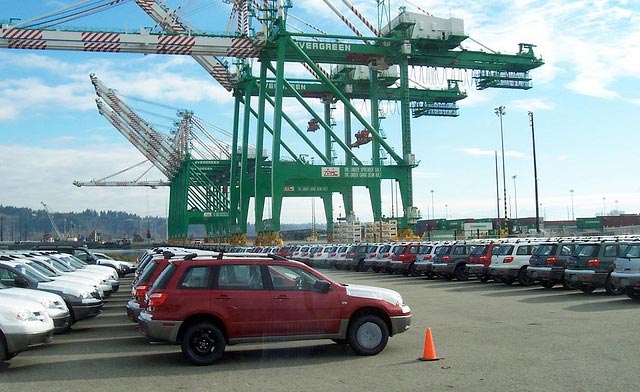
In a bold move aimed at reshaping America’s trade landscape, President Donald Trump announced on Wednesday a 25% tariff on all automobiles and auto parts imported into the United States, effective April 3, 2025.
The proclamation, delivered from the Oval Office, marks a considerable escalation in Mr. Trump’s tariff-centric economic agenda, targeting an industry critical to both US manufacturing and global supply chains. The measure, paired with hints of forthcoming ‘reciprocal tariffs,’ underscores his administration’s commitment to bolstering domestic production while challenging decades of free-trade orthodoxy.
The new tariffs will apply to finished vehicles—sedans, SUVs, minivans, cargo vans, and light trucks—as well as key components like engines, transmissions, powertrain parts, and electrical systems.
President Trump framed the policy as a cornerstone of his ‘Made in America’ vision, projecting it will generate over $100 billion in annual revenue and spur a renaissance in U.S. auto manufacturing. ‘If you build your car in the United States, there’s no tariff,’ Mr. Trump declared, emphasizing that the levies aim to incentivize companies to relocate factories stateside.
The announcement sent shockwaves through the global auto sector, which relies heavily on integrated North American and international supply chains.
In 2024, the US imported roughly 8 million vehicles—half of the 16 million sold domestically—valued at $240 billion, with Mexico, Japan, South Korea, Canada, and Germany leading the pack. Nearly 60% of parts in U.S.-assembled vehicles also originate abroad.
Industry experts warn that the tariffs could add $4,000 to $10,000 to the cost of imported cars, with ripple effects likely pushing up prices across the market, including for American-made models reliant on foreign components.
A partial reprieve for North America
Vehicles and parts qualifying under the United States-Mexico-Canada Agreement (USMCA)—signed during Mr. Trump’s first term—will receive a partial exemption.
Tariffs will apply only to the non-US content of these goods, with the US Customs and Border Protection tasked with finalizing the process by May 3. For example, a car assembled in Mexico with 50% American-made parts would face a reduced 12.5% tariff on its foreign content.
However, this carveout offers little comfort to Canada and Mexico, where leaders decried the move as a ‘direct attack’ on their economies. Canadian Prime Minister Mark Carney vowed to defend his nation’s workers, while Mexico’s auto sector—accounting for 5% of its GDP—braces for a potential $181 billion hit.
Reciprocal tariffs on the Horizon
The auto tariffs come ahead of a broader trade salvo Trump has dubbed ‘Liberation Day,’ slated for April 2. On that date, he plans to unveil ‘reciprocal tariffs’ designed to mirror the duties foreign nations impose on US exports.
Speaking to reporters, Trump softened his tone slightly, suggesting these levies might be ‘lenient’ and include breaks for some countries. ‘People will be very surprised at how conservative they are,’ he said, though he offered no specifics.
Earlier hints from the administration suggest rates could climb as high as 25% or more in sectors like semiconductors and pharmaceuticals, with phased increases over the next year to pressure firms into building U.S. facilities.
Economic and Political Fallout
The auto tariff plan has drawn sharp reactions.
The United Auto Workers union hailed it as a lifeline for blue-collar communities, with president Shawn Fain calling it a major step to reverse decades of manufacturing decline.
Conversely, industry groups like Autos Drive America, representing foreign automakers such as Toyota and BMW, warned of higher prices, fewer consumer options, and job losses in an already strained market.
The average new car price in the US hovers near $50,000, and analysts predict the tariffs could push that figure up significantly within months.
Internationally, allies are gearing up for retaliation. The European Union, facing a potential 30% drop in German car exports to the US, signaled it may reinstate countermeasures from Trump’s first term. Japan and South Korea, major auto exporters, are exploring emergency responses, while the UK—where the US is the second-largest car export market—engaged in urgent talks to mitigate the impact.
Broader Tariff Ambitions
President Trump’s trade strategy builds on actions taken since his January 2025 inauguration. He has already imposed 25% tariffs on steel and aluminum imports and a 10% levy on Chinese goods, with a temporary 25% tariff on Canada and Mexico delayed until March 1 after diplomatic concessions on border security.
On Tuesday, he directed his economic team to craft a comprehensive reciprocal tariff framework, citing a $1 trillion US goods trade deficit in 2024 as evidence of ‘unfair’ global practices. The administration also floated a novel twist: tax deductibility for interest on loans to buy domestically produced cars, a move that could offset rising costs but inflate auto loan sizes and interest rates.
National Security Rationale
Invoking Section 232 of the 1962 Trade Expansion Act, President Trump justified the auto tariffs as a national security imperative, echoing a 2019 Commerce Department probe from his first term.
The White House argues that reliance on foreign vehicles and parts—only 25% of U.S.-sold car content is domestically made—weakens America’s industrial base, a vulnerability highlighted by its World War II-era manufacturing might. Critics, however, call the security link tenuous, accusing Trump of wielding tariffs as a blunt economic weapon.
As markets digest the news—U.S. stocks dipped 0.3% to 2% Wednesday—Trump’s gamble hinges on whether higher costs today can deliver the manufacturing revival he promises. With the auto industry’s fate hanging in the balance, the world watches to see if ‘Liberation Day’ will redefine global trade or spark a costly standoff.